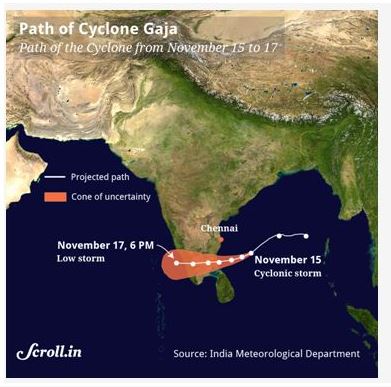ForumIAS announcing GS Foundation Program for UPSC CSE 2025-26 from 19 April. Click Here for more information.
ForumIAS Answer Writing Focus Group (AWFG) for Mains 2024 commencing from 24th June 2024. The Entrance Test for the program will be held on 28th April 2024 at 9 AM. To know more about the program visit: https://forumias.com/blog/awfg2024
Trail of destruction: on damage caused by Cyclone Gaja
News:
- The article discusses about the extent of damage caused by Cyclone Gaja which struck Tamil Nadu recently.
Important Facts:
- About Cyclone Gaja:
- It was the first cyclone to move towards Tamil Nadu in 2018.
- The earlier two named Daye and Titli had made landfall along the Odisha coasts, brought heavy rainfall and damaged the coastal districts of Odisha and Andhra Pradesh.
- Though most of the low pressure areas are formed in the Bay of Bengal or the Arabian sea, some have their roots elsewhere. Gaja is one such cyclone.
- Usually, such cyclones are formed when remnants of typhoons from the Pacific Ocean come into the Indian Ocean or the Bay of Bengal and re-intensify into cyclones when they find warm ocean waters in these regions.
- Cyclone Gaja could have formed from a remnant of Super typhoon Yutu, which had devastated the Philippines in the last week of October.
- Extent of damage caused by the cyclone:
- The suffering, the loss, and the displacement in the districts of Tiruvarur, Nagapattinam, Thanjavur and Pudukottai districts is of an enormous magnitude.
- In its report to the Centre, the Tamil Nadu government has estimated the number of people rendered homeless at 3.7 lakh, and houses destroyed at 3.4 lakh.
- The cyclone has crippled agriculture and livelihoods in a fertile region, felling thousands of productive trees and killing livestock.
- Between 60% and 80% of the coconut trees in the region have fallen, hobbling Tamil Nadu’s farmers, who contribute a quarter of India’s coconuts with the highest unit yield.
- Moreover, unlike paddy or many other crops, bringing coconut plantations back to life will take years.
- Mitigating the damage in future:
- The top priority for the Tamil Nadu government should be to restore administrative systems and service delivery in the affected areas
- Cyclone stricken farmers should be given a moratorium on any agricultural loans that they have taken and a fair compensation scheme should be prepared.
- General efforts to professionalise disaster management:
- The National Cyclone Risk Mitigation Project started by the Ministry of Home Affairs has been working to reduce the impact of such catastrophic events on Andhra Pradesh, Odisha, West Bengal, Tamil Nadu and Gujarat.
- The lead taken by the State Disaster Management Authority in issuing a stream of alerts ahead of Gaja helped coastal residents move to camps and adopt safety measures.
- The active measures taken by the State after the cyclone, notably to clear roads, remove fallen trees and repair power infrastructure and communications, helped restore some stability.
- Way forward:
- Cyclone Gaja has wrought terrible devastation, and the relief programme must match it in scale.
- Tamil Nadu must focus on reducing the hazard through policies that expand resilient housing, build better storm shelters and create financial mechanisms for insurance and compensation.





